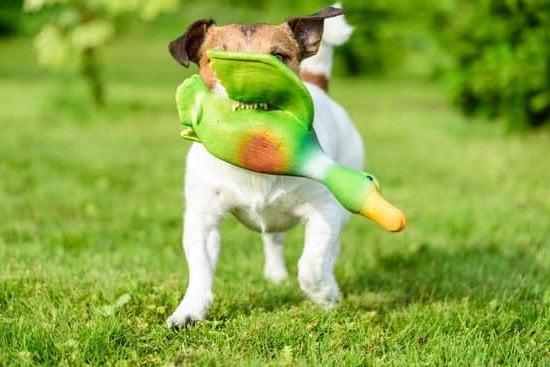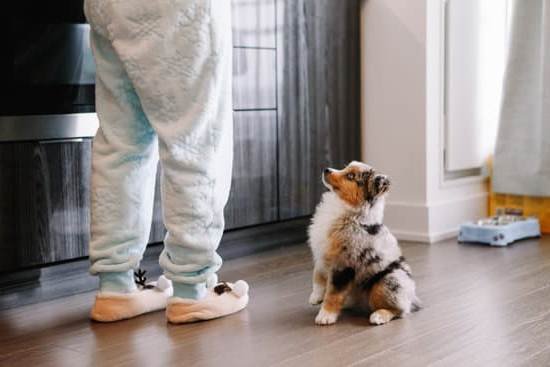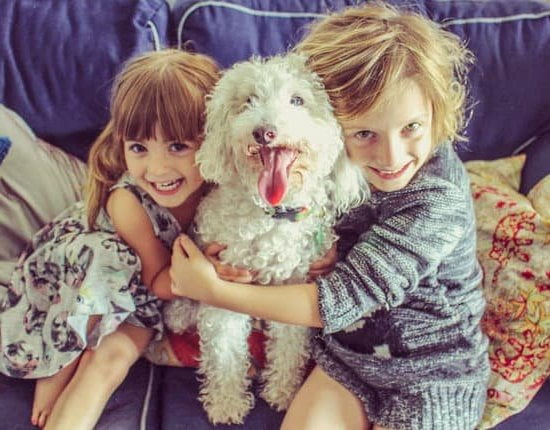Are you constantly asking yourself, “How do I train my dog to pee outside?” Potty training is an essential part of owning a dog, and it’s important for both the pet and the owner. Understanding the importance of potty training for dogs is crucial for a successful and harmonious relationship between you and your furry friend.
Potty training not only helps maintain cleanliness in your home but also teaches your dog proper behavior. It establishes boundaries and helps them understand what is expected of them. Moreover, a well-trained dog can enjoy more freedom around the house and in public spaces, making outings and family gatherings much more enjoyable.
In this article, we will explore the various aspects of potty training your dog. From setting realistic expectations on how long it takes, to understanding the basics of positive reinforcement and consistency, we will provide expert tips to help you navigate through this essential training process successfully.
We will also address common challenges such as marking, fear of going outside, and offer advanced techniques like training your dog to pee on command. Whether you are a new dog owner or need a refresher on potty training best practices, this article has got you covered.
Setting Realistic Expectations
When it comes to potty training your dog, it’s important to set realistic expectations about how long the process will take. Every dog is different, and there are several factors that can influence how quickly your furry friend learns to pee outside. On average, it can take anywhere from 4 to 6 months for a dog to be fully potty trained, but this timeline can vary depending on the breed, age, and individual personality of your pet.
One of the key factors in determining how long it will take to train your dog to pee outside is consistency in your training approach. By establishing a routine and consistently reinforcing positive behavior, you can help speed up the potty training process. Additionally, being patient and understanding that setbacks may occur along the way is crucial in managing your expectations.
It’s also important to keep in mind that older dogs or rescue dogs may require more time and patience when it comes to potty training. Factors such as past experiences or lack of proper training early in life can play a role in how quickly an adult dog learns new behaviors. Understanding these factors can help you set realistic expectations for the potty training timeline for your specific pet.
| Factor | Impact |
|---|---|
| Breed | Can influence learning speed |
| Age | Youger dogs might learn faster |
| Consistency | A key factor accelerating learning process |
| Past experiences |
The Basics of Potty Training
Potty training your dog is an important aspect of their overall behavior and well-being. Using positive reinforcement and consistency in your training methods will greatly contribute to the success of this process. Positive reinforcement involves rewarding your dog for exhibiting desired behavior, such as peeing outside, while consistency ensures that your dog understands the expectations and rules of potty training.
When using positive reinforcement during potty training, it’s important to utilize rewards that are meaningful to your dog. This could be treats, praise, or even playtime. Whenever your dog successfully pees outside, be sure to immediately reward them with their favorite treat or lots of verbal praise. This will help them associate going potty outside with a positive experience.
Consistency is key when it comes to potty training your dog. Establish a routine for taking your dog outside to pee, and stick to it as much as possible. Take them out first thing in the morning, after meals, before bedtime, and at regular intervals throughout the day. By doing this consistently, you are helping your dog understand when and where they should go potty.
By using positive reinforcement and consistency in your potty training efforts, you can effectively teach your dog to pee outside. Remember that every dog is different, so be patient and understanding throughout the process. With time and dedication, you’ll see progress and eventually achieve success in potty training your furry friend.
Choosing the Right Time and Place for Potty Breaks
When it comes to potty training your dog, choosing the right time and place for potty breaks is crucial for success. By following a consistent schedule and being mindful of your dog’s behavior, you can set them up for successful potty training. Here are some considerations to keep in mind:
– **Establish a Routine**: Dogs thrive on routine, so it’s important to establish a regular schedule for potty breaks. Take your dog outside first thing in the morning, after meals, before bedtime, and at regular intervals throughout the day. Consistency is key to reinforcing good potty habits.
– **Observe Your Dog’s Behavior**: Pay attention to your dog’s body language and behavior to determine when they need to go outside. Signs that your dog may need a potty break include sniffing around, circling, or suddenly becoming restless. By recognizing these cues, you can proactively take your dog outside before accidents happen indoors.
– **Choose a Designated Potty Area**: Designate a specific spot in your yard or outdoor area where you want your dog to relieve themselves. Bringing them to the same spot each time will help them understand what is expected of them. The scent of their previous visits will also prompt them to go in that area again.
By being mindful of the timing and location of potty breaks, you can effectively reinforce positive potty training habits in your dog. Remember that patience and consistency are key components of successful potty training.
Dealing With Accidents
Understanding the Normalcy of Accidents
It is important for dog owners to understand that accidents are a normal part of the potty training process. Dogs, especially puppies, have small bladders and may not always be able to hold it in until they are brought outside.
It’s crucial to stay patient and calm when accidents occur, as reacting negatively can have a detrimental effect on the training process. Instead, focus on how to handle setbacks and use them as learning opportunities for both you and your dog.
Immediate Clean-Up and Neutralization
When accidents happen indoors, it’s important to clean up the mess right away using an enzymatic cleaner that neutralizes the odor. Dogs have a strong sense of smell and if they can still detect their urine or feces in an area, they may continue to eliminate there. By thoroughly cleaning the accident site, you can help prevent repeat incidents in the same spot.
Re-Evaluating Your Training Approach
If accidents start happening frequently or if your dog seems to be struggling with potty training, it may be time to re-evaluate your approach. Consider whether you are providing enough opportunities for bathroom breaks, if your praise and rewards are effectively reinforcing good behavior, or if there are any medical issues that could be contributing to accidents. Sometimes a slight adjustment in your training method can make a big difference in your dog’s progress.
Tips for Encouraging Your Dog to Signal When They Need to Go Outside
Training your dog to signal when they need to go outside is an important aspect of potty training. This not only helps prevent accidents in the house but also strengthens the communication between you and your furry friend. One effective method for encouraging this signaling behavior is through bell training.
Hang a small bell by the door that you use to take your dog outside, and every time before going out, prompt your pooch to touch the bell with their nose or paw. Once they do, reward them with a treat and open the door for a potty break. With consistent practice, your dog will learn to associate ringing the bell with going outside.
Another useful technique for encouraging signaling is through observing your dog’s natural behavior. Pay attention to any unique actions or sounds that they make right before they have to relieve themselves. It could be circling, sniffing around, or pacing back and forth near the door. Once you identify these signals, encourage and praise them whenever they exhibit these behaviors. Soon enough, they will learn to communicate their need to go outside using these cues.
Consistency is key when teaching your dog to signal when they need to go outside. Make sure everyone in the household follows the same routine and positively reinforces any attempts at signaling. By being patient and understanding of your dog’s individual learning pace, you can effectively encourage them to communicate their potty needs in a way that works for both of you.
The Role of Crate Training in Potty Training
Crate training plays a crucial role in potty training your dog. It helps create a routine and teaches your dog to hold their bladder and bowels, ultimately leading to successful housebreaking. By using a crate, you can limit the space your dog has access to when unsupervised, reducing the chances of accidents indoors. This article will discuss the importance of crate training in potty training and how to effectively incorporate it into the process.
When crate training your dog for potty training purposes, it is important to choose the right size crate. The crate should be big enough for your dog to stand up, turn around, and lie down comfortably, but not too large that they can separate a sleeping area from their bathroom spot. Dogs instinctively avoid soiling their living space, so having just enough room in the crate will encourage them to hold it until they are taken outside.
It’s essential to make the crate a positive and comfortable space for your dog. Introduce them to the crate gradually by placing treats or toys inside and creating positive associations with it. Avoid using the crate as a form of punishment, as this can create negative feelings towards it and delay the potty training process. With consistency and patience, most dogs will learn to view their crate as a safe haven and an effective tool for potty training.
Addressing Common Challenges
When potty training your dog, you may encounter common challenges such as marking behaviors, fear of going outside, and other issues that can hinder the training process. Here are some tips for addressing these challenges:
1. Marking Behaviors: Some dogs, especially male dogs, may exhibit marking behaviors inside the house even after being fully potty trained. To address this issue, consider getting your dog neutered or spayed if they are not already. Additionally, make sure to thoroughly clean any marked areas with an enzyme-based cleaner to eliminate the scent and discourage future marking in the same spot.
2. Fear of Going Outside: If your dog is showing fear or reluctance to go outside to potty, it’s important to determine the underlying cause. It could be due to a previous negative experience or simply fear of unfamiliar outdoor stimuli. To help your dog overcome this fear, gradually acclimate them to the outdoor environment by starting with short and positive outdoor experiences and gradually increasing the duration and exposure over time.
3. Other Issues: Some dogs may have other issues that make potty training more challenging, such as submissive urination or excitement urination. It’s important to address these issues with patience and positive reinforcement. Consult with a professional dog trainer or behaviorist if needed to develop a personalized plan for overcoming these specific challenges.
By identifying and addressing these common challenges during the potty training process, you can help set your dog up for success and create a positive and effective training experience for both you and your furry companion.
Advanced Techniques
Training your dog to pee on command can be a useful skill, especially for pet owners with busy schedules or limited outdoor opportunities. Teaching this advanced technique can require some extra time and effort, but the results can provide convenience and peace of mind in various situations.
To start training your dog to pee on command, it’s important to observe their natural bathroom behavior. Take note of any specific cues or signals your dog exhibits right before they eliminate, such as circling or sniffing in a certain area. Once you have identified these behaviors, you can begin associating a verbal cue, such as “go potty,” with the act of elimination.
During each potty break, use the verbal cue consistently right before your dog starts to pee. As soon as they finish peeing, offer them praise and a small treat to reinforce the connection between the verbal cue and the action. With consistent practice and positive reinforcement, your dog will eventually learn to associate the command with the behavior of peeing.
As with any form of training, patience is crucial when teaching your dog to pee on command. It may take some time for them to understand and respond to the verbal cue consistently. Be patient and consistent with your training sessions, and don’t get discouraged if progress seems slow at first. With dedication and persistence, your dog will eventually learn to pee on command reliably.
Celebrating Success
In conclusion, successfully potty training your dog to pee outside is a significant achievement that requires patience, consistency, and positive reinforcement. By understanding the importance of potty training for dogs and setting realistic expectations for the process, you can effectively train your dog to do their business in the appropriate place. Using positive reinforcement and consistency in your training methods will help reinforce the desired behavior of peeing outside.
Choosing the right time and place for potty breaks, as well as addressing accidents with patience and understanding, are crucial steps in the potty training process. Additionally, crate training can play a helpful role in establishing a routine for your dog’s potty breaks. It is also important to address common challenges such as marking and fear of going outside, using advanced techniques like training your dog to pee on command.
Finally, celebrating success by recognizing milestones and graduating from potty training is an essential part of the process. This not only reinforces positive behavior for your dog but also allows you to acknowledge the progress made throughout the training journey. With dedication and commitment, you can successfully train your dog to pee outside, leading to a happier and more harmonious relationship between you and your furry friend.
Frequently Asked Questions
How Long Does It Take to Train a Dog to Pee Outside?
The time it takes to train a dog to pee outside can vary depending on the dog’s age, prior training, and breed. Typically, it may take anywhere from a few weeks to a few months for a dog to consistently pee outside. Consistency, positive reinforcement, and patience are key factors in successful potty training.
How Can I Attract My Dog to Pee Outside?
Attracting your dog to pee outside involves establishing a routine, taking them to the same spot each time, and using positive reinforcement when they eliminate outdoors. Additionally, you can try using specific cues or commands that signal to your dog that it’s time to go potty.
Using treats or praise when they do their business outside can also help reinforce this behavior.
How Do I Transition My Dog From Peeing Inside to Outside?
Transitioning your dog from peeing inside to outside requires gradually introducing them to the outdoor environment for elimination. This may involve leash training them and taking them out frequently, especially after meals or naps.
It’s essential to keep an eye on your dog for any signs that they need to go and then promptly take them outside. Over time, they will begin associating the outdoor environment with pottying and will make the transition naturally.

Welcome to the blog! I am a professional dog trainer and have been working with dogs for many years. In this blog, I will be discussing various topics related to dog training, including tips, tricks, and advice. I hope you find this information helpful and informative. Thanks for reading!





